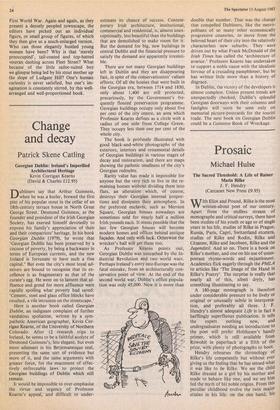Prosaic
Michael Hulse
The Sacred Threshold: A Life of Rainer Maria Rilke J. F. Hendry (Carcanet New Press £9.95) With Eliot and Pound, Rilke is the most written-about poet of our century. Apart from the endless stream of monographs and critical surveys, there have been studies of his youth or age or of single years in his life, studies of Rilke in Prague, Russia, Paris, Capri, Switzerland etcetera, studies of Rilke and Rodin, Rilke and Cezanne, Rilke and Jacobsen, Rilke and the Jugendstil. And so on. There is a book on Rilke's mother, and one on his use of unim- portant rhyme-words and enjambment. Academics flick eagerly through the PMLA to articles like `The Image of the Hand in Rilke's Poetry'. The surprise is really that nearly all of this, albeit dryly, has something illuminating to say.
A 180-page monograph is therefore under considerable pressure to be lively or original or unusually subtle in interpreta- tion, and preferably all three. J. F. Hendry's almost adequate Life is in fact a bafflingly superfluous publication. It tells the expert nothing new, and undergraduates needing an introduction to the poet will prefer Holthusen's handy primer, which is still available from Rowohlt in paperback at a fifth of the price, with plenty of photographs to boot. Hendry rehearses the chronology of Rilke's life competently but without ever giving us the feeling that he has sensed what it was like to be Rilke. We see the child Rilke dressed as a girl by his mother and made to behave like one, and we see hint fed the myth of his noble origins. From this peculiar childhood evolve the twin major strains in his life: on the one hand, his
warped empathy with women, his role as
in-
ability for women, together with his n-
ability to sustain a love; on the other, the diligence with which Rilke fished for invita- tions to the homes of aristocrats, as single- minded as Ibsen coveting state decorations. We follow his friendship with Lou Andreas-Salomt, his discovery of Russia, his spell in the Worpswede artists' colony and marriage to the wife, Clara, whom he so systematically pushed to a corner of his life, and his sojourn with Rodin in Paris. After this, any biography of Rilke becomes dull, and Hendry's is no exception: only a sensitive gift for describing people and Places can make the catalogue of Rilke's patrons and homes interesting, and neither the voice whispering the opening of the First Elegy, nor Rilke's experience of the First World War in the Viennese Military Records Office, is quite the material of stimulating biography. Hendry aridly declines to make the attempt to bring out even a hint of vividness. The poseur in Rilke, wearing a blouse and speaking broken German on his return from Russia, or developing a fondness (during his rela- tionship with Benvenuta) for Chopin's Funeral March because its 'tragedy seemed that of his own life', has an almost alarming effect in Hendry's parched prose, and his sycophantic begging letters, which careful creation of context can reveal as a natural Part of a European tradition in patronage, seem very distasteful in Hendry's telling. I don't suggest that this is how he meant Nice to be seen. Rather, I think it is an unintended side-effect of his lack of sym- pathy for Rilke which finally strips this Life of insight or understanding. This is true not only of Hendry the biographer but also of Hendry the critic. The best writing on Rilke, however muffled in academic formulations, betrays that at point the critic took Rilke's oxygen into his bloodstream. This goes for the best of Rilke's English language critics too, such as Belmore, Wood and Mason; Hendry, however, generally reads like a Sunday newspaper review written as a routine chore: 'These are verses dealing with love, dreams and death, refined and romantic- ised, full of Pre-Raphaelitish emotion, yet conveying a real sense of landscape and nature.' And so on. Even the New Poems and the Notebooks of Mahe Laurids Brigge are only skimpily glanced at. Hendry's rri ore careful scrutiny is reserved for the ma- Jor achievements, the Sonnets to Orpheus and the Duino Elegies, which are given 20 pages to themselves at the end, but here too „is. analysis is literal-minded and super- Ile 'a, and the reader who really needs help will still do best to turn to Stahl, Guardini Jacob Steiner. And our confidence is hardly won by the author's own mis- translations: 'recoiling' has found its way Into Archaic Torso of Apollo', where the :Nord 'zurtIckgeschraubt' actually means !timed down' (like an oil-lamp, say), and the dogs in the Tenth Elegy 'cock up a leg', although 'haben Natur' in fact means they are copulating. True, Rilke is the despair of
all translators. But since Hendry's version of the 'Archaic Torso of Apollo' dispenses with Rilke's metre and rhyme scheme, why can he not — like Rilke's first English language translator, Mrs Herter Norton, who did the same — at least provide word- for-word accuracy? This book is presumably aimed at the safe library market. I can imagine that there may be a gap in the British market for an authoritative introduction of a kind that might have found a home in the Fontana Modern Masters series, but J. F. Hendry's study isn't that book.







































 Previous page
Previous page